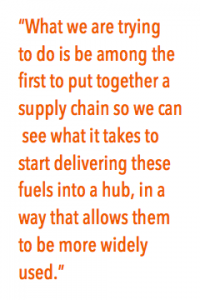
An earlier version was originally published in the Toronto Star.
Canada’s aviation sector made history in 2012 after a number of test flights showed that renewable jet fuel could be blended with regular fuel without affecting airplane performance.
It started in April, when Porter Airlines used a blend of 50 per cent “biojet” fuel on a Bombardier turboprop, which successfully flew from the Toronto island airport to Ottawa. Two months later, Air Canada flight AC991 carried passengers from Toronto to Mexico City using a similar 50/50 mix. It was the first of two commercial test flights Air Canada conducted that year.
“We took 43 per cent of the carbon out of that flight,” said Teresa Ehman, the airline’s director of environmental affairs. “It was phenomenal. But it raised the next question: Why does this not happen every day?”
Environmental groups want an answer. Airline flight and passenger volumes are expected to double over the next 15 years, and if the aviation sector doesn’t change its behaviour, that also means a doubling of greenhouse-gas emissions — from slightly less than 2 per cent today to a projected 4 or 5 per cent by 2050.
At the Paris climate conference in December, there was pressure from a variety of parties to have the aviation sector included in the final text of the resulting international agreement. It didn’t work. Airlines were once again left to their own devices. Initially included as part of the Kyoto Protocol, oversight of international aviation emissions got punted in the 1990s to the International Civil Aviation Organization, which has sat on the issue for two decades and continues to be the chosen overseer. A plan of action is expected to be hammered out this year, but critics warn not to expect anything mandatory or ambitious.
The entire situation frustrates the European Union, which has tried twice to impose a carbon fee on international flights into and out of Europe. It backed down from its most recent attempt in 2014 after U.S. and Chinese airlines threatened to ignore it, but the EU signalled it would revive the effort if ICAO didn’t have its own plan in place by 2017.
The bottom line: airlines need to step up their emissions-reduction game, and biofuels are expected to play a major role.
Will biojet fuel take off?
In many ways, making biojet fuel is the easiest part of the mission to decarbonize aviation. Many companies are already producing it in limited quantities, using ingredients that range from canola and camelina to animal fats and algae.
The bigger challenge, said Ehman, is coming up with an efficient and economical way of safely getting fuel from a production facility all the way to an airplane’s wing. Biofuels are an important component, but without a supporting infrastructure and supply chain that allows it to be consumed on a large scale across all Canadian airports, the market for this fuel will never grow large enough to matter.
 To tackle this barrier, Air Canada has teamed with experts from industry and academia on a project that will blend 400,000 litres of biojet fuel with an existing fuel-delivery system at a soon-to-be-chosen airport. The current approach — driving a truck directly to the airplane — creates a parallel system that is too expensive and impractical in commercial volumes.
To tackle this barrier, Air Canada has teamed with experts from industry and academia on a project that will blend 400,000 litres of biojet fuel with an existing fuel-delivery system at a soon-to-be-chosen airport. The current approach — driving a truck directly to the airplane — creates a parallel system that is too expensive and impractical in commercial volumes.
“It’s not just knowing if these fuels can work in the planes, because that is known already,” said Warren Mabee, director of the Institute for Energy and Environmental Policy at Queen’s University, which is part of the initiative. “What we are trying to do is be among the first to put together a supply chain so we can see what it takes to start delivering these fuels into a hub in a way that allows them to be more widely used.”
Fred Ghatala, who as partner with Vancouver-based consultancy Waterfall Group is leading the research effort, said it comes down to lower costs in an industry where fuel purchasing and delivery represents a substantial part of an airline’s operational budget. “Reducing costs where possible when using low-carbon fuels is fundamental to the future of those fuels.”
The University of Toronto, McGill University and the International Air Transport Association are also part of the project as members of the BioFuelNet Aviation Task Force. Funding is coming from the Green Aviation Research and Development Network, which gets its support from the federal government and Canada’s aerospace sector.
Crucial to get it right
Ehman said Air Canada has been working to solve this carbon dilemma for nearly five years. After its biofuel test flights, the airline worked with Airbus and the BioFuelNet team to study Canada’s ability to supply biojet fuel, asking how much the country could produce and how much the fuel would cost. It then passed that research along to Transport Canada, which did its own Canadian feasibility study.
The industry has to get it right. For its part, Air Canada has done a good job of finding efficiencies in its operations, with measures to reduce aircraft weight, improve fleet maintenance and streamline routes. Out of 20 transatlantic airlines measured for operational efficiency, Canada’s biggest airline tied for fourth place behind only KLM, Aer Lingus, Airberlin and Norwegian Air, according to a November report from the International Council on Clean Transportation.
In Europe, airports themselves are committing to be carbon-neutral by 2030 through an increase in efficiency and use of solar power. But on-the-ground or in-the-air efficiency can only go so far, said Ehman, pointing out that fuel consumption represents more than 95 per cent of any airline’s emissions.
As a global industry, airlines have made a voluntary commitment to increase the fuel efficiency of their fleets by 1.5 per cent annually and achieve carbon-neutral growth beyond 2020. By 2050, the industry says it will cut its absolute GHG emissions in half compared to 2005 levels.
The only way to get there is with biofuels, and if that’s going to happen, Air Canada wants to make sure a vibrant market is developed domestically to keep jobs and money in the country. “There’s a paradigm shift happening,” said Ehman. “It’s important for Canada to take a lead in this.”
Mabee echoed that view. “This is the way the world is moving. We have to deal with emissions in every sector, somehow. So let’s figure this out.”
Canada’s advantage
Canada is in an ideal position to lead development of aviation biofuels.
For one, it has all the resources it needs to sustainably produce vast quantities of biofuel, whether from agricultural and forest residues or specially grown oilseed crops such as canola or camelina. Second, the country has the domestic expertise to refine those materials into a certifiable product that the industry can trust.
Homegrown companies such as Hamilton-based Biox and Enerkem of Montreal could be ideal producers of the fuel down the road. “They have the building blocks to start assembling those types of molecules,” said Mabee, director of the Institute for Energy and Environmental Policy at Queen’s University. “But the key part of this, what is missing, is a policy driver for it. We don’t have a government mandate to make these fuels.”
A renewable fuel standard, like the federal requirement that gasoline contain at least 5 per cent ethanol, is one policy option. Another is a B.C.-style low-carbon fuel standard, which requires a 10 per cent reduction in the carbon intensity of gasoline by 2020. Putting the aviation sector under the umbrella of a carbon tax might also be considered.
But it makes no sense to knock on the government’s door if a barrier such as fuel distribution makes it overly difficult for the industry to comply. And while some might ask why batteries or hydrogen or solar technology isn’t being considered as an alternative, Mabee offers a reality check. “Solar planes and battery-powered planes are nice research efforts, but practically biofuels are the only way to go.”
This article was part of a series produced in partnership by the Toronto Star and Tides Canada to address a range of pressing climate issues in Canada leading up to and following the United Nations Climate Change Conference in Paris. Tides Canada supported the partnership to increase public awareness and dialogue around the impacts of climate change on Canada’s economy and communities. The Toronto Star had full editorial control and responsibility to ensure stories are rigorously edited in order to meet its editorial standards.
SOURCE: CLEAN | BREAK – Read entire story here.







